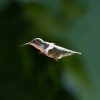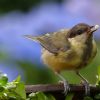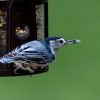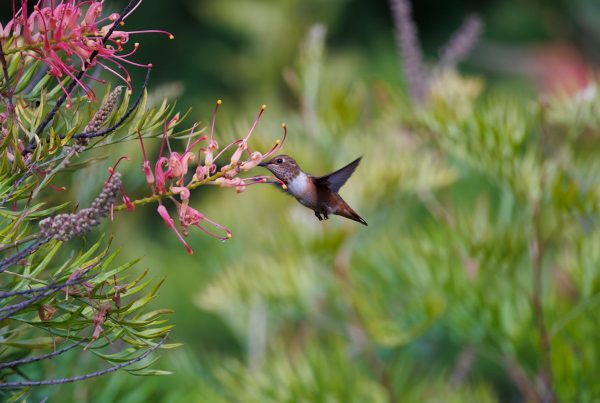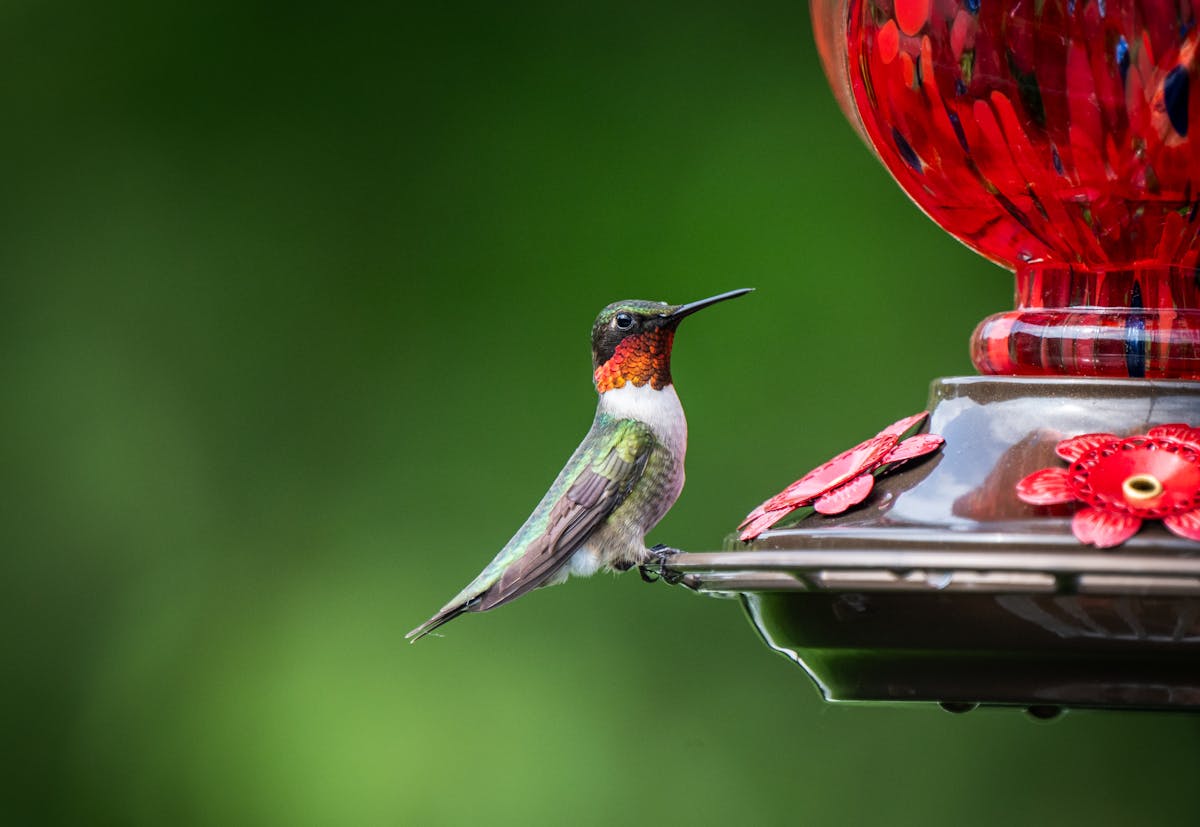
Ruby Throated Hummingbird
When we are going to identify Ruby Throated Hummingbird male vs female characteristics then, the primary distinction between male and female ruby-throated hummingbirds is their throat color. Males have a bright red throat called a gorget. Females, on the other hand, have a white throat. Sometimes, their throats have dark streaks or spots. Females are usually larger than males. They have rounded tails with white tips, while males have forked tails. The Anna’s Hummingbird is medium-sized. It has a short, straight bill and a gently sloping forehead. Both sexes exhibit a bronze-green coloration on their upper bodies and gray beneath. Males stand out with their bright red heads and throats. Females, on the other hand, have green heads and small red markings on their throats.
Females have black tails with white tips, while males have solid blackish-gray tails.
Male Ruby-throated Hummingbirds:
-
Distinctive red throat: Males boast a bright, iridescent ruby-red throat.
-
Black chin: A black chin is visible under the red throat.
-
Forked tail: They have a deeply forked tail with pointed feathers.
-
Smaller size: Males are slightly smaller than females, but the difference is minor.
-
Iridescent feathers: The red throat feathers shimmer and reflect various colors in light.
Female Ruby-throated Hummingbirds:
-
White throat: Females have a plain white throat instead of vibrant red.
-
Rounded tail: Their tail feathers are rounded, with white tips.
-
Larger size: Typically, females are a bit larger than males.
-
Subdued colors: Females show more muted colors than males.
-
Dark streaks or spots: Sometimes, females have dark streaks or spots on their white throats.
Juvenile Males:
-
Similar to females: Young males look like females and lack the red throat patch.
-
Early signs of red: Some may show hints of red as summer goes on, but won’t have a full gorget until after their first winter.
-
Juvenile males have textured, “scaly” feathers on their heads and bodies. This is different from the smooth feathers of adult females.
Adult Ruby-throated Hummingbirds, or Archilochus colubris, show clear differences between males and females.
Juvenile males copy females until their first winter. Then, they get the plumage of adult males. This resemblance can complicate the identification of age and sex during summer and fall after fledglings have left the nest. From May to October, don’t just think all white-throated hummingbirds at feeders are females. Some might be young males. For more details on ruby-throated hummingbirds and how to tell their age and sex, please click below.
SIZE COMPARISON IN RUBY-THROATED HUMMINGBIRDS
A Ruby-throated Hummingbird is about 3 inches (7.5 cm) long when it sits. Its bill makes up roughly one-fifth of that length.
Adult females of this species are 15-25% larger than males. This size difference is unusual in the animal kingdom. Not all male hummingbirds are bigger than females, so size isn’t a reliable way to tell them apart. Hummingbirds fly right after leaving their nests, so you won’t see “baby hummingbirds” at feeders. In fact, young birds are not capable of flight.
If you spot a small hummingbird by a flower or feeder, it’s probably a Hummingbird Moth, not a baby bird. The photo above features a young male Ruby-throated Hummingbird. This one hasn’t fully developed its red throat.
FEATHER PATTERN
Ruby-throated Hummingbirds usually have shiny green feathers on their backs. Some may appear more muted or vibrant.
Generally, adult males are darker than both females and younger males. Hummingbird colors come from their structure. They can change with light and angle.
In low light, a Ruby-throated Hummingbird can look nearly black instead of its usual green or red.
For Adult Males:
-
The throat shines ruby-red, sometimes with a golden or bronze tint.
-
The back is a bright green or bronze-green.
-
The wings seem almost black.
-
The tail feathers are pointed and dark, with no white tips.
-
The tail is forked.
-
The breast and belly often appear brownish-gray.
-
The sides have a metallic bronze-green sheen.
-
The crown displays a dark green metallic color.
The white area beneath the gorget can give the impression of a light ring around the neck.
The adult male has a gray breast, dark tail, and bright red throat. This makes him look much darker than females or younger males, especially in dim light.
For females: Their throat is white or has faint buff streaks. Sometimes, an older female may have a rare black or red throat feather. Their back shines green or bronze-green. The wings look almost black, and the tail feathers are rounded. The outer three tail feathers have white tips, and the tail is fan-shaped. The belly and vent are white, while the sides are light brown. The crown has a metallic dark green color.
YOUNG
The young male looks like the female. However, it often has dark streaks on the throat. These can be green, black, or sometimes buff. By late summer, young males often exhibit one or more red feathers on their throats. Most birds that have distinct streaking on their throats are young males; refer to the photos below for clarification. Young males and females can show brownish edges on their green body feathers. This is especially noticeable on the crown and back.
You can tell the age of white-throated Ruby-throated Hummingbirds at a feeder in spring, before the young birds have fledged.

Ruby Throated Hummingbird male vs female
ADULT MALES
Only adult male Ruby-throated Hummingbirds have a full red gorget (shown in the top photo). This red color gives the species its name, but it may not be visible from the side (as seen in the bottom photo).
All female Ruby-throated Hummingbirds, young or old, have white throats. These throats can show light gray or buff streaks (illustrated in the two photos above).
Some older females may have one or two black feathers on their throats, as shown below. Rarely, a single red feather might appear. Young males can resemble females, as explained in the next section.
JUVENILE MALES (see above)
A young male Ruby-throated Hummingbird may have a white throat like a female. However, it often has black or green streaks, like a “five o’clock shadow.” The bird above shows the most noticeable streaking we’ve seen. The one above it has a more usual pattern. As summer ends, young males might show a few red throat feathers. They won’t get a full red gorget until their first winter.
When they return in spring, some researchers think that these males may have a jagged bottom edge on their gorget. They might show one or more brownish feathers instead of red. This change could help indicate their age, but more research is needed.
Every young male Ruby-throated Hummingbird grows a full red gorget in their winter homes. So, when they migrate back to the U.S. and Canada in spring, they look like adult males.
Sometimes, a few individuals that stay in the U.S. for the winter don’t migrate to Mexico or Central America. They can show “arrested development,” keeping dark throat streaking until late spring. Then, they quickly grow a full red gorget.
Adult male Ruby-throated Hummingbirds (left) have pointed tail feathers that are dark and have no white tips. Their tails are forked.
Young males (right) look like females of all ages. They have white tips on the outer three tail feathers on each side. Their feathers are rounded, and they have a fan-shaped tail. It’s hard to tell the sex of hummingbirds at feeders in early summer. Young males and females look very similar as they begin to leave the nest. In spring, you can spot an adult female hummingbird by its white tail tips.
The bill of the Ruby-throated Hummingbird has a color that ranges from dull black to shiny black. At times, it may seem white or yellow due to pollen stuck on it. Young birds have a bill with faint lines called “corrugations.” These lines begin at the tip and either fade or wear down over time. After approximately 6 to 8 months, the bill generally looks smooth. However, even fully grown birds might still display some corrugations near the bill’s base. These tiny lines often require a magnifying glass to be seen clearly and are typically only noticeable on birds being held. The second image shows that this bird’s bill tip is becoming smooth. This means it has about 80% corrugations. It is a young bird, close to the end of its first summer. Like many bird species, younger birds have a yellow gape, which is the area at the corner of the mouth (see images below). In contrast, adult birds have gapes that are ivory, white, or pinkish-white.




